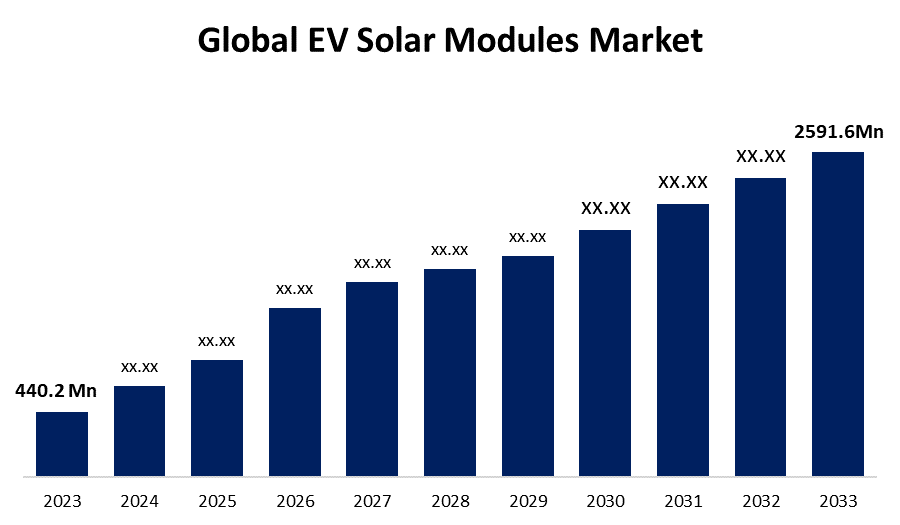Global EV Solar Modules Market Size, Share, and COVID-19 Impact Analysis, By Solar Panel Type (Monocrystalline and Polycrystalline), By Battery Type (Lithium-ion, Lead-Acid, and Lead-Carbon), By Application (Passenger Vehicles and Commercial Vehicles), and By Region (North America, Europe, Asia-Pacific, Latin America, Middle East, and Africa), Analysis and Forecast 2023 - 2033.
Industry: Energy & PowerGlobal EV Solar Modules Market Insights Forecasts to 2033
- The Global EV Solar Modules Market Size was Valued at USD 440.2 Million in 2023
- The Market Size is Growing at a CAGR of 19.40% from 2023 to 2033
- The Worldwide EV Solar Modules Market Size is Expected to Reach USD 2591.6 Million by 2033
- Aisa Pacific is Expected to Grow the fastest during the forecast period.

Get more details on this report -
The Global EV Solar Modules Market Size is Anticipated to Exceed USD 2591.6 Million by 2033, Growing at a CAGR of 19.40% from 2023 to 2033.
Market Overview
EV solar module is often a solar panel or array designed to charge electric vehicles (EVs) with solar energy. The electricity generated can be used to directly charge EV batteries, minimizing reliance on grid power and encouraging sustainable energy behaviors. EV solar modules are part of the larger trend of integrating renewable energy sources with transportation infrastructure to minimize carbon footprints and improve energy efficiency. The EV solar module can help to reduce environmental and noise pollution. Significant benefits of EVs with solar modules include lower charging costs and zero carbon emissions. The EV solar modules market includes solar photovoltaic modules that are specifically engineered and optimized for integration into electric vehicles. EV solar modules are lightweight yet durable panels fitted on various exterior surfaces of EVs, such as the roof, hood, trunk, or other components, to create additional power for the vehicles.
Report Coverage
This research report categorizes the market for EV solar modules market based on various segments and regions forecasts revenue growth and analyzes trends in each submarket. The report analyses the key growth drivers, opportunities, and challenges influencing the EV solar modules market. Recent market developments and competitive strategies such as expansion, product launch, and development, partnership, merger, and acquisition have been included to draw the competitive landscape in the market. The report strategically identifies and profiles the key market players and analyses their core competencies in each sub-segment of the EV solar modules market.
Global EV Solar Modules Market Report Coverage
| Report Coverage | Details |
|---|---|
| Base Year: | 2023 |
| Market Size in 2023: | USD 440.2 Million |
| Forecast Period: | 2023-2033 |
| Forecast Period CAGR 2023-2033 : | 19.40% |
| 2033 Value Projection: | USD 2591.6 Million |
| Historical Data for: | 2019-2022 |
| No. of Pages: | 240 |
| Tables, Charts & Figures: | 110 |
| Segments covered: | By Solar Panel Type, By Battery Type, By Application, By Region |
| Companies covered:: | Volkswagen, Canadian Solar, JA Solar, Trina Solar, SunPower, Capsolar, Maxeon Solar Technology, Innolia, LONGI Solar, Jinko Solar, REC Group, Sharp Corporation, Soalrever, and Others |
| Pitfalls & Challenges: | Covid 19 Impact Challanges, Future, Growth and Analysis |
Get more details on this report -
Driving Factors
The growth of the EV solar module market is driven by several factors including the increasing need for energy-efficient alternatives to fossil fuels due to diminishing supplies and rising costs, growing environmental awareness leading to demand for cleaner transportation options, and advancements in solar technology making vehicles more durable, flexible, and efficient. Government support for eco-friendly vehicles, such as electric and solar-powered vehicles, drives the EV solar module market growth worldwide. The government support includes tax incentives for consumers and subsidies for manufacturers to reduce costs. Investments in charging infrastructure and emission standards are also accelerating adoption. EV solar module enhances their sustainability and reduces dependency on external power sources. Additionally, advancements in solar technology continue to improve efficiency and integration into vehicle design, making solar-powered EVs increasingly viable and appealing to eco-conscious consumers.
Restraining Factors
The EV solar module market faces a major challenge due to high manufacturing costs, necessitating significant capital investments in production facilities. The integration of solar modules into electric vehicles (EVs) offers potential benefits such as extended range and reduced dependency on external charging infrastructure, aligning with sustainability goals. However, challenges include the limited efficiency of solar panels on vehicles, design considerations, technological limitations, and regulatory hurdles. The limited sales of solar-powered vehicles in cold regions stem from reduced energy generation by solar panels in low temperatures also hindering market growth.
Market Segmentation
The EV solar modules market share is classified into solar panel type, battery type, and application.
- The monocrystalline segment is estimated to hold the highest market revenue share through the projected period.
Based on the solar panel type, the EV solar modules market is classified into monocrystalline and polycrystalline. Among these, the monocrystalline segment is estimated to hold the highest market revenue share through the projected period. Monocrystalline panels are made of a single silicon crystal, resulting in a homogeneous structure that allows more sunlight to be absorbed and converted into power more efficiently. The clarity and precision of the crystal lattice allow monocrystalline panels to attain conversion efficiencies of around 20%, which is several percentage points greater than other varieties. Because of their superior efficiency, monocrystalline panels might produce more electricity from the same amount of sunshine exposure as polycrystalline or thin-film equivalents. Monocrystalline is the greatest choice for commercial and utility applications requiring maximum energy production due to its stable performance throughout time and virtually no degradation.
- The lithium-ion segment is anticipated to hold the largest market share through the forecast period.
Based on the battery type, the EV solar modules market is divided into lithium-ion, lead-acid, and lead-carbon. Among these, the lithium-ion segment is anticipated to hold the largest market share through the forecast period. Because of their capacity to provide EVs with a better range, lithium-ion batteries have recently gained favor in EVs and are anticipated to have the largest rate of growth. Lithium-ion (Li-Ion) batteries are lightweight and have a higher energy density, resulting in a vehicle with increased efficiency and range. Another advantage of Li-ion batteries is that they weigh one-third less than lead-acid batteries. Furthermore, the charging time required to charge is substantially shorter about 3 hours or less than lead-acid batteries.
- The passenger vehicles segment dominates the market with the largest market share through the forecast period.
Based on the application, the EV solar modules market is categorized into passenger vehicles and commercial vehicles. Among these, the passenger vehicles segment dominates the market with the largest market share through the forecast period. Several segments attributed the growth of the passenger vehicle segment, firstly the cost-effectiveness and space efficiency of integrating solar modules on smaller roof areas of passenger cars compared to larger commercial vehicles like trucks and buses. Individual drivers benefit from reduced operating costs and enhanced fuel efficiency, while the stationary nature of parked passenger vehicles optimizes solar energy harvesting.
Regional Segment Analysis of the EV Solar Modules Market
- North America (U.S., Canada, Mexico)
- Europe (Germany, France, U.K., Italy, Spain, Rest of Europe)
- Asia-Pacific (China, Japan, India, Rest of APAC)
- South America (Brazil and the Rest of South America)
- The Middle East and Africa (UAE, South Africa, Rest of MEA)
North America is anticipated to hold the largest share of the EV solar modules market over the predicted timeframe.

Get more details on this report -
North America is anticipated to hold the largest share of the EV solar modules market over the predicted timeframe. North America is poised to lead the EV solar modules market due to its technological innovation, supportive government policies, growing consumer demand for sustainable energy solutions, robust infrastructure development, and the presence of key industry players. Several states, including California, have implemented zero-emission vehicle programs that require automakers to sell a specific percentage of emissions-free vehicles each year thus resulting in a steady demand for the EV solar module market. In the North American region, continuous developments are expanding customer knowledge and interest in the potential of EV solar modules.
Asia Pacific is expected to grow at the fastest CAGR growth of the EV solar modules market during the forecast period. Several reasons contribute to Asia Pacific's predicted rapid growth in the EV solar modules industry including increasing adoption of electric cars (EVs) and solar energy technology. Countries like China, Japan, South Korea, and India have ambitious plans to raise EV infrastructure and promote renewable energy sources. Furthermore, the Asia-Pacific area benefits from strong manufacturing capabilities and technological advances in solar module production. Additionally, government regulations and incentives targeted at decreasing carbon emissions and promoting sustainable energy solutions help to promote the growth of the Asia Pacific EV solar modules market.
Competitive Analysis:
The report offers the appropriate analysis of the key organizations/companies involved within the EV solar modules market along with a comparative evaluation primarily based on their product offering, business overviews, geographic presence, enterprise strategies, segment market share, and SWOT analysis. The report also provides an elaborative analysis focusing on the current news and developments of the companies, which includes product development, innovations, joint ventures, partnerships, mergers & acquisitions, strategic alliances, and others. This allows for the evaluation of the overall competition within the market.
List of Key Companies
- Volkswagen
- Canadian Solar
- JA Solar
- Trina Solar
- SunPower
- Capsolar
- Maxeon Solar Technology
- Innolia
- LONGI Solar
- Jinko Solar
- REC Group
- Sharp Corporation
- Soalrever
- Others
Key Target Audience
- Market Players
- Investors
- End-users
- Government Authorities
- Consulting And Research Firm
- Venture capitalists
- Value-Added Resellers (VARs)
Recent Developments
- In February 2024, Trina Solar Co., Ltd., a global pioneer in smart PV and energy storage solutions, unveiled a new full black module, Vertex S+ 450W (NEG9R.25), aimed at high-end residential rooftops.
- In February 2024, Navitas Solar unveiled its latest n-type TOPCon bifacial modules with power outputs from 560 W to 630 W per panel and efficiency ranging from 21.7% to more than 22%.
Market Segment
This study forecasts revenue at global, regional, and country levels from 2023 to 2033. Spherical Insights has segmented the EV solar modules market based on the below-mentioned segments:
Global EV Solar Modules Market, By Solar Panel Type
- Monocrystalline
- Polycrystalline
Global EV Solar Modules Market, By Battery Type
- Lithium-ion
- Lead-Acid
- Lead-Carbon
Global EV Solar Modules Market, By Application
- Passenger Vehicles
- Commercial Vehicles
Global EV Solar Modules Market, By Regional Analysis
- North America
- US
- Canada
- Mexico
- Europe
- Germany
- UK
- France
- Italy
- Spain
- Russia
- Rest of Europe
- Asia Pacific
- China
- Japan
- India
- South Korea
- Australia
- Rest of Asia Pacific
- South America
- Brazil
- Argentina
- Rest of South America
- Middle East & Africa
- UAE
- Saudi Arabia
- Qatar
- South Africa
- Rest of the Middle East & Africa
Frequently Asked Questions (FAQ)
-
1. What is the CAGR of the EV solar modules market over the forecast period?The EV solar modules market is projected to expand at a CAGR of 19.40% during the forecast period.
-
2. What is the market size of the EV solar modules market?The Global EV Solar Modules Market Size is Expected to Grow from USD 440.2 Million in 2023 to USD 2591.6 Million by 2033, at a CAGR of 19.40% during the forecast period 2023-2033.
-
3. Which region holds the largest share of the EV solar modules market?North America is anticipated to hold the largest share of the EV solar modules market over the predicted timeframe.
Need help to buy this report?